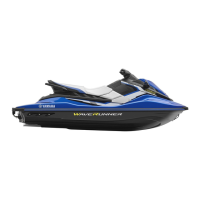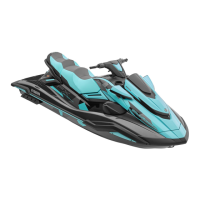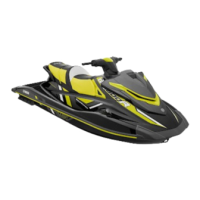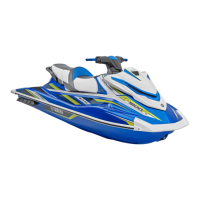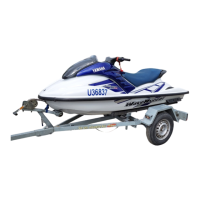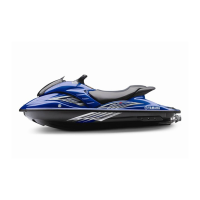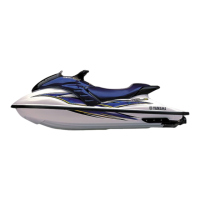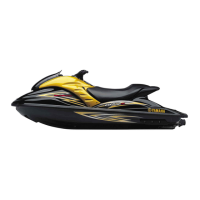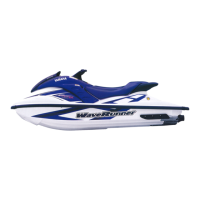Do you have a question about the Yamaha WaveRunner GP1800 2017 and is the answer not in the manual?
Declaration of Conformity for Personal Watercraft (PWC) with Directive 2013/53/EU.
Details on watercraft and engine descriptions, including essential requirements.
Records PRI-ID, CIN, and engine serial numbers for parts and security.
Location of the date label attached to the cylinder head.
Details on model name, design category, and builder's plate information.
Overview of various labels on the watercraft for user awareness.
Explains various warning labels and their importance for safety.
Details on additional labels, including CE marking and emission standards.
Specifies age, supervision, and passenger limits for safe operation.
Guidelines for safe operation, scanning, speed, and avoiding hazards.
Essential gear like PFDs, protective clothing, and eye protection for riders.
Covers alcohol, drugs, pre-checks, operator posture, modifications, and safety cords.
Lists essential items like sound signals, distress signals, watch, and towline.
Details risks of exhaust fumes, hot components, magnetic forces, and enclosed spaces.
Explains jet thrust, OTS system, and engine management for steering and deceleration.
Safety considerations and responsibilities when pulling skiers or wakeboarders.
Legal requirements and safe operating practices for waterways.
Emphasizes respect for others, nature, and proper maintenance for environmental care.
Defines terms like Trolling speed, Planing speed, Bow, Stern, Port, and Starboard.
Identifies key external parts of the watercraft with diagrams.
Identifies handlebar controls like levers, switches, and information displays.
Identifies components within the engine compartment.
Overview of controls for security and operation modes.
Details on using the transmitter for security and Low RPM Mode.
Explains the function and operation of the security system and its modes.
Instructions for using engine stop and shut-off switches for safety.
How to start the engine, including warnings and precautions.
Operation of throttle and RiDE levers for speed and reverse control.
How handlebars control the jet thrust nozzle for directional changes.
Checks for proper engine cooling water discharge.
Function and draining procedure for the water separator.
Overview of basic functions like shifting and controls.
How to shift between forward, neutral, and reverse using RiDE and throttle.
Adjusting jet thrust nozzle angle for trim and performance.
Explains functions like Low RPM Mode for engine speed limitation.
Overview of the display and its initial operation.
Details on various indicators like trim, tachometer, and speedometer.
How to read speed and engine RPM from the instruments.
Understanding indicators for gear position and jet thrust nozzle trim.
Shows fuel level and warning for low fuel.
Alerts for low oil pressure and recommended actions.
Explains engine overheat and check engine warnings with remedies.
Indicates total engine running hours for maintenance tracking.
Displays battery voltage and indicates issues.
Instructions for removing and installing front and rear seats.
Usage of handgrips and reboarding steps for safety and convenience.
Usage of bow eye, stern eyes, and cleats for securing and towing.
Details on bow, glove, and watertight storage capacities and load limits.
How to open, close, and secure the removable watertight storage compartment.
Location and use of the fire extinguisher holder and cover.
Specifies recommended fuel type, octane rating, and gasohol guidelines.
Step-by-step procedure for safely filling the fuel tank.
Recommends oil type, grade, and cautions about usage.
Procedure for checking the engine oil level using the dipstick.
Steps to drain bilge water from the engine compartment.
Guidelines for securely tying down the watercraft on a trailer.
Essential steps for breaking in the engine to ensure longevity and performance.
Comprehensive checklist of items to inspect before operating.
Specific checks to perform before launching the watercraft.
Checks to perform after launching and starting the engine.
General advice and familiarization with controls before operation.
Importance of practice and reading manual for safe riding.
Emphasizes pre-operation checks, local laws, and defensive riding.
Correct posture for operator and passengers for stability and control.
Steps and precautions for safely launching from a trailer or shore.
Procedure and safety warnings for starting the engine in the water.
How to stop the engine using the stop switch and importance of throttle for steering.
Securing the watercraft to prevent unauthorized use when unattended.
Forward operation using throttle lever and display indicators.
How throttle and handlebar input affect turning, including OTS system.
Methods of slowing down and stopping, and importance of stopping distance.
Shifting between reverse, neutral, and forward using RiDE lever.
Procedures for boarding from water, including using the reboarding step.
Safety precautions and steps for starting to move from a stationary position.
Procedure for righting a capsized watercraft and safety warnings.
Steps for safely beaching and docking the watercraft.
Precautions and techniques for operating in areas with thick weed growth.
Steps to discharge cooling water and prepare for storage.
General advice on cleaning and storing the watercraft after use.
Procedure to flush cooling passages to prevent clogging.
Detailed steps for washing and cleaning the hull, deck, and engine compartment.
Guidelines for battery maintenance, removal, and storage.
Preparations for storing the watercraft for extended periods.
Lubricating moving parts and applying rust inhibitors for protection.
Importance of periodic checks and lubrication for safety and efficiency.
Information about the tool kit provided with the watercraft.
Steps for removing and installing the engine cover for access.
Schedule of recommended maintenance tasks based on hours or months.
Recommendations and procedures for changing engine oil and filter.
How to diagnose and resolve common watercraft issues using the chart.
Steps for handling urgent situations like jet intake clogs.
Steps to remove debris from the jet intake and impeller safely.
Manual procedure to raise the reverse gate if it fails to operate.
Instructions for jump-starting the battery using another vehicle.
Guide on identifying blown fuses and replacing them with correct types.
Procedures and safety precautions for towing a disabled watercraft.
Steps for handling and servicing a submerged or flooded watercraft.
| Model | WaveRunner GP1800 |
|---|---|
| Year | 2017 |
| Displacement | 1812cc |
| Fuel Capacity | 18.5 gallons |
| Dry Weight | 769 lbs |
| Engine Type | 4-cylinder, 4-stroke |
| Horsepower | 250 hp |
| Fuel Type | Unleaded |
| Length | 131.9 inches |
| Seating Capacity | 3 |
| Rider Capacity | 1-3 |
| Passenger Capacity | 2 persons |
